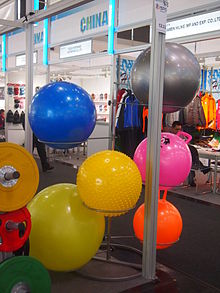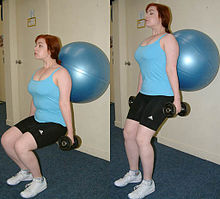Exercise ball
An exercise ball is a great ball of mostly colored, highly elastic plastic material with which one gymnastic can perform exercises.
Applications
The ball offers opportunities for gymnastics exercises, especially back training , to strengthen the muscles of the back, stomach and buttocks.
It offers a second use in the office or at home as a temporary replacement for the office chair at the desk. The exercise ball is very easy on the back, as you change your position slightly while sitting on it. Nevertheless, you shouldn't spend about 30 to 90 minutes on it all day, only with interruptions. Because of its health-promoting properties, especially for the spine , it is recommended by doctors and health insurance companies. Occupational safety advisors advise against using it as an office chair, as there is a significant risk of accidents due to the lack of backrest and stability.
In obstetrics , this ball is a recognized aid for births. The delivering woman can sit on the ball with her legs apart to open the birth canals and take advantage of gravity while her partner holds and supports her from behind.
Exercise balls are often used in preparation for the birth . Because the pelvic floor is more stressed during pregnancy , exercises on an exercise ball are generally considered useful.
Another very popular application, especially in school sports , is the game of Pezzi football , also known as the elephant ball .
Pezziball
The "PEZZI" -Gymnastikball shortly Pezziball , is the best known member of the gymnastics ball. The name is a word mark of the Italian company Ledragomma, which has been manufacturing exercise balls since 1950.
Technical characteristics
An average exercise ball - which is also suitable for sitting in terms of load capacity (i.e. a sitting ball ) - usually has a diameter between 45 cm and 75 cm and is very firmly inflated. Exercise balls, which are intended for sitting, can also have supports to stabilize the ball.
The optimal size of the ball depends on the height of the user. It should be about as high as the chair you usually sit on. In addition, the values in the table below can be used as guide values. Nevertheless, you should always try sitting or doing gymnastics to get a feel for the size actually required. An incorrect size can lead to various complications for the user. These include back pain and a long-term uncomfortable and unhealthy sitting posture.

| Body height | Arm length | ⌀ |
|---|---|---|
| 140 cm | 45-55 cm | 45 cm |
| up to 155 cm | 56-65 cm | 55 cm |
| up to 175 cm | 66-80 cm | 65 cm |
| up to 185 cm | 81-90 cm | 75 cm |
| from 190 cm | 91-100 cm | 85 cm |
If the exercise ball is to be used as a sitting ball, the length of the lower leg is used as a basis for size orientation .
| Lower leg length | Ball size |
|---|---|
| 35-37 cm | 45 cm |
| 38-47 cm | 55 cm |
| 48-57 cm | 65 cm |
| 58-67 cm | 75 cm |
| 68-77 cm | 85 cm |
Space security
Exercise balls, which are intended for sitting, are often differentiated according to their maximum weight capacity and their space security.
Space security is understood to mean the behavior of the outer skin in the event of damage, e.g. B. by sharp-edged objects such as broken glass, grit or sharp-edged metal. If the outer skin of an exercise ball that is not burst-proof is damaged, a long crack can suddenly appear and the entire volume of air escapes immediately.
The outer skin of a burst-proof exercise ball prevents further tearing even if it is damaged. This is achieved through a thicker outer skin (0.5 mm to 3 mm) and a special material mix. The air thus escapes slowly and enables the user to get off the ball in good time. The security of space is only given up to a certain weight load. Usually this is between 70 kg and 100 kg. Since there are no standardized regulations for determining and testing the load capacity, some manufacturers only give a static load capacity (the user sits motionless and the ball is therefore only loaded by the person's weight). The dynamic load capacity is stated less often (the user moves on the ball), but this corresponds to the actual use.
Manufacturers usually refer to burst resistant , burst proof or anti-burst balls . Due to the lack of a test standard, there have been accidents in the past with balls that were referred to as burst resistant and still burst.
Accident prevention
To avoid accidents caused by a fall, the ball can be filled with less air during gymnastics exercises. This makes the ball more stable on the floor. Another possibility, which is used for stabilization, is the ball cup, a ball support made of plastic. These measures are also applicable to the sitting ball.
See also
Web links
Individual evidence
- ↑ Exercise ball also during pregnancy? | Fit with exercise ball . In: Fit with an exercise ball . May 19, 2017 ( fit-mit-gymnastikball.de [accessed June 12, 2017]).
- ↑ Ledragomma company and brand history . Retrieved May 9, 2019
- ↑ Sacramento Kings file lawsuite over exercise ball incident. (No longer available online.) In: The Huffington Post. The Huffington Post, December 1, 2010, archived from the original on December 6, 2010 ; Retrieved January 15, 2011 . Info: The archive link was inserted automatically and has not yet been checked. Please check the original and archive link according to the instructions and then remove this notice.
- ↑ Contribution to the gymnastics (Pezzi ball) and sitting ball - How to inflate correctly? gymnastikball-sitzball.de
